
Chinese art is visual art that originated in or is practiced in China, Greater China or by Chinese artists. Art created by Chinese residing outside of China can also be considered a part of Chinese art when it is based on or draws on Chinese culture, heritage, and history. Early "Stone Age art" dates back to 10,000 BC, mostly consisting of simple pottery and sculptures. After that period, Chinese art, like Chinese history, was typically classified by the succession of ruling dynasties of Chinese emperors, most of which lasted several hundred years. The Palace Museum in Beijing and the National Palace Museum in Taipei contains extensive collections of Chinese art.
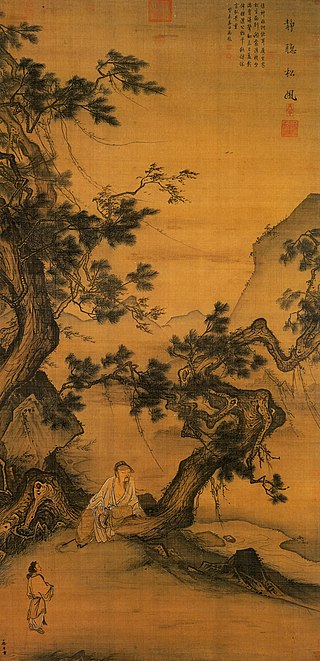
Chinese painting is one of the oldest continuous artistic traditions in the world. Painting in the traditional style is known today in Chinese as guó huà, meaning "national painting" or "native painting", as opposed to Western styles of art which became popular in China in the 20th century. It is also called danqing. Traditional painting involves essentially the same techniques as calligraphy and is done with a brush dipped in black ink or coloured pigments; oils are not used. As with calligraphy, the most popular materials on which paintings are made are paper and silk. The finished work can be mounted on scrolls, such as hanging scrolls or handscrolls. Traditional painting can also be done on album sheets, walls, lacquerware, folding screens, and other media.

Tang dynasty art refers to Chinese art created during the Tang dynasty (618–907). The period saw significant advancements in arts such as painting, sculpture, calligraphy, music, dance, and literature. During the Tang dynasty, the capital city Chang'an, was the most populous city in the known world, and the era is generally regarded by historians as a high point in Chinese civilization and a golden age of Chinese literature and art.

A Persian carpet or Persian rug, also known as Iranian carpet, is a heavy textile made for a wide variety of utilitarian and symbolic purposes and produced in Iran, for home use, local sale, and export. Carpet weaving is an essential part of Persian culture and Iranian art. Within the group of Oriental rugs produced by the countries of the "rug belt", the Persian carpet stands out by the variety and elaborateness of its manifold designs.

A thangka is a Tibetan Buddhist painting on cotton, silk appliqué, usually depicting a Buddhist deity, scene, or mandala. Thangkas are traditionally kept unframed and rolled up when not on display, mounted on a textile backing somewhat in the style of Chinese scroll paintings, with a further silk cover on the front. So treated, thangkas can last a long time, but because of their delicate nature, they have to be kept in dry places where moisture will not affect the quality of the silk. Most thangkas are relatively small, comparable in size to a Western half-length portrait, but some are extremely large, several metres in each dimension; these were designed to be displayed, typically for very brief periods on a monastery wall, as part of religious festivals. Most thangkas were intended for personal meditation or instruction of monastic students. They often have elaborate compositions including many very small figures. A central deity is often surrounded by other identified figures in a symmetrical composition. Narrative scenes are less common, but do appear.
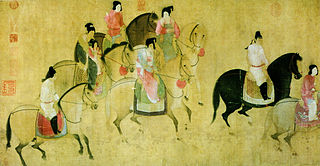
Zhang Xuan (713–755) was a Chinese painter who lived during the Tang Dynasty (618–907).

The Seven Sages of the Bamboo Grove were a group of Chinese scholars, writers, and musicians of the third century CE. Although the various individuals all existed, their interconnection is not entirely certain. Several of the seven were linked with the Qingtan school of Daoism as it existed in the state of Cao Wei.

Kesi is a technique in Chinese silk tapestry. It is admired for its lightness and clarity of pattern. At first, this technique was chiefly used to protect scrolls containing paintings. It was also employed as a support for paintings, later going on to become an esteemed art form. This art form especially flourished between the eleventh and thirteenth centuries.

Mawangdui is an archaeological site located in Changsha, China. The site consists of two saddle-shaped hills and contained the tombs of three people from the Changsha Kingdom during the western Han dynasty : the Chancellor Li Cang, his wife Xin Zhui, and a male believed to have been their son. The site was excavated from 1972 to 1974. Most of the artifacts from Mawangdui are displayed at the Hunan Provincial Museum. It was called "King Ma's Mound" possibly because it was (erroneously) thought to be the tomb of Ma Yin (853–930), a ruler of the Chu kingdom during the Five Dynasties and Ten Kingdoms period. The original name might have been the similarly-sounding "saddle-shaped mound".

Chinese clothing includes the traditional hanfu and garments of ethnic minorities, as well as modern variations of indigenous Chinese dresses. Chinese clothing has been shaped through its dynastic traditions, as well as through foreign influences. Chinese clothing showcases the traditional fashion sensibilities of Chinese culture traditions and forms one of the major cultural facets of Chinese civilization.
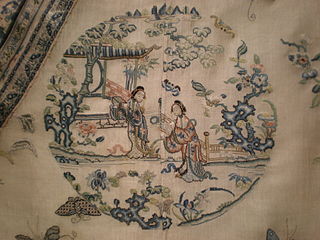
Chinese embroidery refers to embroidery created by any of the cultures located in the area that makes up modern China. It is some of the oldest extant needlework. The four major regional styles of Chinese embroidery are Suzhou embroidery, Hunan embroidery, Guangdong embroidery and Sichuan embroidery. All of them are nominated as Chinese Intangible Cultural Heritage.

The Admonitions Scroll is a Chinese narrative painting on silk that is traditionally ascribed to Gu Kaizhi, but which modern scholarship regards as a 5th to 8th century work that may or may not be a copy of an original Jin dynasty (266–420) court painting by Gu. The full title of the painting is Admonitions of the Court Instructress. It was painted to illustrate a poetic text written in 292 by the poet-official Zhang Hua (232–300). The text itself was composed to reprimand Empress Jia (257–300) and to provide advice to the women in the imperial court. The painting illustrates this text with scenes depicting anecdotes about exemplary behaviour of historical palace ladies, as well as with more general scenes showing aspects of life as a palace lady.

Byzantine silk is silk woven in the Byzantine Empire (Byzantium) from about the fourth century until the Fall of Constantinople in 1453.
The handscroll is a long, narrow, horizontal scroll format in East Asia used for calligraphy or paintings. A handscroll usually measures up to several meters in length and around 25–40 cm in height. Handscrolls are generally viewed starting from the right end. This kind of scroll is intended to be read or viewed flat on a table, in sections. The format thus allows for the depiction of a continuous narrative or journey.

Hanfu are the traditional styles of clothing worn by the Han Chinese. There are several representative styles of hanfu, such as the ruqun, the aoqun, the beizi and the shenyi, and the shanku.
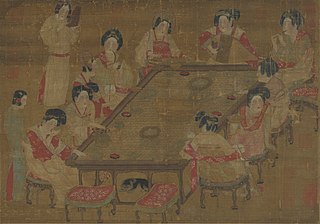
A Palace Concert is a Chinese Tang dynasty silk painting showing ten court ladies and two standing servant maidens around a large rectangular table. Some court ladies are depicted drinking tea, while others drink wine. The four women at the far end are presumably responsible for playing music and livening up the mood. The musical instruments depicted, from left to right, are bamboo pipes, guqin, pipa and bili. One of the servant maidens plays a clapper to maintain beat. A small dog is depicted under the table. The artist and the precise year of the painting are unknown. The painting is housed in the National Palace Museum in Taipei, Taiwan.

Qixiong ruqun, which can also be referred as Qixiong shanqun, also known as "chest-high ruqun", is a set of attire in hanfu, the traditional Chinese clothing worn by the Han Chinese. The qixiong ruqun is a unique style of ruqun, which is characterized with a high waistline qun, Chinese skirt. The qun used in the qixiong ruqun is generally tied above the bust level. It was worn by women during the Southern dynasties, Sui dynasty, Tang dynasty and Five Dynasties and Ten Kingdoms period. The style was also revived in the early and middle Ming dynasty.

After the fall of the Tang dynasty, the Khitans, a branch of the Eastern Xianbei tribes, established Liao dynasty in northern China. The Liao dynasty comprised two regions: the Northern and Southern Divisions. The Northern divisions of Liao was mainly composed of tribal Khitan people while the Southern regions was composed of the Han and other sedentary groups. The rulers of the Liao dynasty adopted a clothing system which allowed the coexistence of Han and Khitan clothing.

The Birth of Mani is a Manichean silk cloth color painting painted in the Fujian Zhejiang area during the Yuan period, depicting the founder of the sect Mani The scene of birth, a scholar who specializes in Manichaeism Ma Xiaohe called it "a rare treasure". This picture is now in the collection of Japan Kyushu National Museum. The drawing technique and artistic style are similar to "Mani's Community Established" and "Mani's Parents", "The Birth of Mani" and "Manichean Universe Map". " It was originally part of a large-scale Manichean silk painting, but now the silk painting has been lost, leaving only the birth picture.
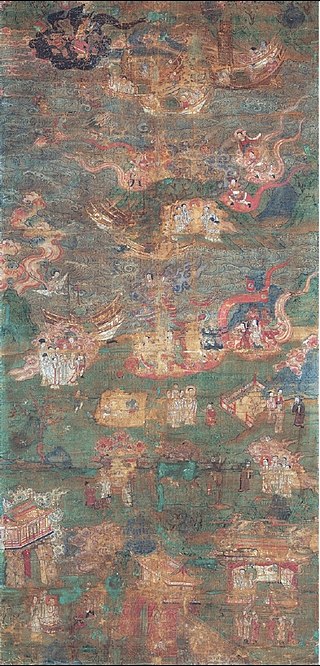
Episodes from Mani's Missionary Work is a Manichean silk color painting drawn in the coastal area of southern China during the yuan to ming period. It is now in a private Japanese collection. The whole picture can be roughly divided into five scenes, depicting the missionary process of a Manichean elector. According to Hungary Asian religious art historian Zsuzsanna Gulácsi, this priest is probably the founder of Manichaeism Mani himself. This painting was originally part of a large-scale Manichean silk painting. The drawing technique and artistic style are similar to "Mani's Community Established" and "Mani's Parents", "The Birth of Mani" and "Manichean Universe Map".


















